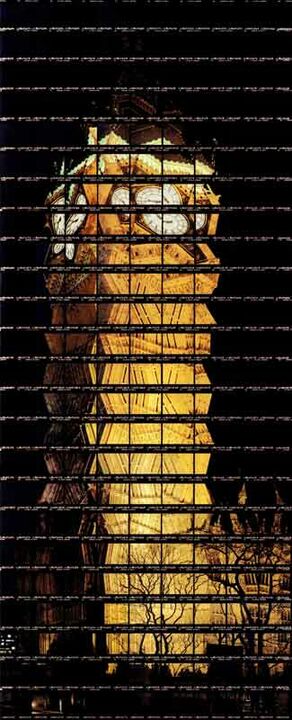Augustus Welby Northmore Pugin (1812 – 1852)
Augustus Welby Northmore Pugin, born 1812, was an English-born architect, designer and theorist of design now best known for his work on churches and on the Houses of Parliament.
He was the son of a émigré French draughtsman, Augustus Charles Pugin, who came to England to escape the Revolution. His father trained him to draw Gothic buildings for use as illustrations in his books. Together they published 3 books on Gothic architecture and designes, which was their and specially his key to Gothic architecture. In this way the younger Pugin diccovered a wide knowledge about the Gothic style from an early age on.
In 1833 he was working with Sir Charles Barry on designs for King Edward’s School, Birmingham. This collaboration was followed in 1835-6 by detailed designs for Barry's entries in the competition to build the new Houses of Parliament.
After the burning of the Houses of Parliament in 1834, Pugin was employed by Sir Charles Barry to work on the new Parliament buildings in London.
1835 was the big turning point in Pugin’s career. His book Gothic Furniture in the Style of the Fifteenth Century was published with great success. In the same year he built his first house, St Marie’s Grange, Salisbury, and most importantly, converted to Catholicism.
A.W.N. Pugin died, at the age of 40, in1852.
Important Buildings in England
House designs
- St Marie’s Grange, Alderbury
- Derby presbytery
- Scarisbrick Hall
- Uttoxeter presbytery
- Keighley presbytery
- Bishop’s House, Birmingham
- Warwick Bridge presbytery
- Clergy House, Nottingham
- Bilton Grange
- Oxenford Grange farm buildings
- Cheadle presbytery
- Woolwich presbytery
- Brewood presbytery
- St Augustine’s Grange (“The Grange”), Ramsgate
- Alton Castle
- Oswaldcroft, Liverpool
- Lanteglos-by-Camelford rectory
- Rampisham rectory
- Fulham presbytery
- Wilburton Manor House
Institutional designs
- Westminster Palace
- Convent of Mercy, Bermondsey
- Mount St. Bernard Abbey
- Convent of Mercy, Handsworth
- St John’s Hospital, Alton
- Convent of St Joseph, school and almshouses, Chelsea, London
- Convent of Mercy, Liverpool
- Spechley school and schoolmaster’s house
- Ratcliffe College
- Liverpool Orphanage
- Convent of Mercy, Nottingham
- Mercy House and cloisters, Handsworth
- St Anne’s Bedehouses, Lincoln
- Convent of the Good Shepherd, Hammersmith, London
- Convent of St Joseph’s, Cheadle
Major Ecclesiastical Designs
- St James', Reading
- St Mary’s, Derby
- Oscott College Chapel
- Our Lady and St Thomas of Canterbury, Dudley
- St Anne’s, Keighley
- St Alban’s, Macclesfield
- St Benedict Abbey (Oulton Abbey), Stone, Staffordshire
- St Augustine’s, Solihull
- St Marie’s, Southport
- St Marie’s, Uttoxeter
- St Wilfred’s, Hulme, Manchester
- Chancel of St John’s, Banbury
- St Chad’s, Birmingham
- St Giles’, Cheadle
- St Oswald’s, Liverpool
- St George’s Cathedral, Southwark, London
- Holy Trinity, Radford
- Our Lady and St Wilfred, Warwick Bridge
- St Marie’s, Brewood
- St Marie’s, Liverpool
- St Augustine’s, Kenilworth
- St Marie’s, Newcastle-upon-Tyne
- St Barnabas’ Cathedral, Nottingham
- St Marie’s, Stockton-on-Tees
- Jesus Chapel, Ackworth Grange, Pontefract
- St John the Evangelist, Kirkham
- St Peter’s, Woolwich
- St Winifrede’s, Shepshed
- St Peter and Paul, Albury Park
- Our Lady and St Thomas, Northampton
- St Wilfrid’s, Cotton
- St Peter’s, Marlow
- St Augustine’s, Ramsgate
- St Marie’s, Rugby
- St Lawrence’s, Tubney
- St Edmund's College chapel, Old Hall Green
- St Marie’s, West Tofts
- St Thomas of Canterbury, Fulham
- St Osmond’s, Salisbury
- Chancel of St Oswald’s, Winwick
- Old Codgers Cottage (Windermere)
- Erdington Abbey, Birmingham
- Chapel restoration, Jesus College, Cambridge
- Rolle Mortuary Chapel, Bicton Grange, Bicton
- St Nicholas' Church, Boldmere,Sutton Coldfield









